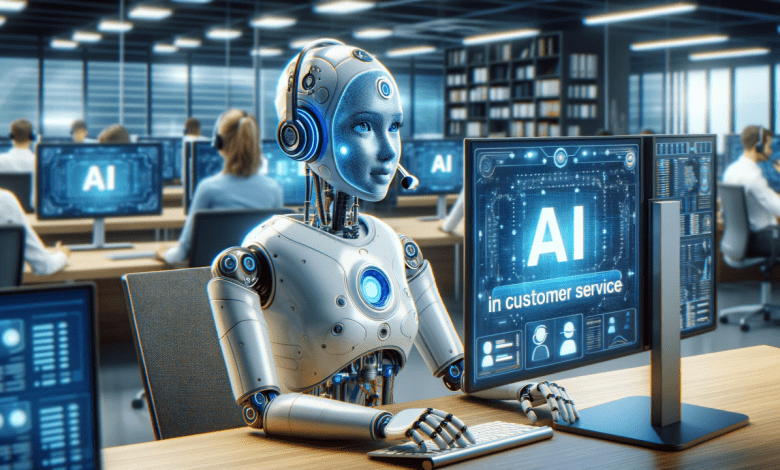AI in Customer Service: The Rise of Smart Chatbots


The blog post AI in Customer Service: The Rise of Smart Chatbots explores the transformative impact of AI customer service in today’s business landscape. It begins with an overview of how AI is reshaping customer interactions, emphasizing the modern approaches adopted by businesses. The article delves into chatbot automation, highlighting their features and benefits, such as 24/7 availability and cost efficiency. It also discusses the role of Natural Language Processing (NLP) support bots in enhancing customer experiences by providing more personalized interactions. Finally, the key takeaways offer actionable strategies for implementing AI in customer service effectively, ensuring businesses can leverage technology to improve engagement and satisfaction. Overall, this informative piece underscores the significance of integrating AI customer service solutions to meet evolving consumer expectations.
Understanding AI In Customer Service: A Modern Approach
AI customer service has revolutionized the way businesses interact with their customers, leading to significant improvements in efficiency and customer satisfaction. By leveraging advanced technology, companies are able to provide 24/7 support, reduce operational costs, and enhance the overall user experience. The use of AI in this domain not only facilitates quicker responses to customer inquiries but also allows for personalized service, making each interaction more valuable. As businesses increasingly adopt these tools, the integration of chatbot automation becomes essential for maintaining a competitive edge in today’s digital marketplace.
Key Developments in AI Customer Service
- Natural Language Processing (NLP): Enables chatbots to understand and respond to human language effectively.
- Predictive Analytics: Helps anticipate customer needs and preferences based on historical data.
- Omnichannel Support: Provides seamless customer experiences across multiple platforms.
- Sentiment Analysis: Assesses customer emotions to tailor responses appropriately.
- Integration with CRM Systems: Streamlines customer information access for personalized service.
- Self-service Capabilities: Empowers customers to find solutions on their own, reducing support demands.
- Multi-language Support: Enhances accessibility for diverse customer bases worldwide.
As the landscape of customer service continues to evolve, organizations must not only adopt AI customer service technologies but also ensure their implementation aligns with broader business goals. The benefits derived from chatbot automation are vast, including improved response times, better resource allocation, and enhanced customer loyalty. Moreover, with AI-driven solutions, businesses can constantly improve their service quality through ongoing learning and adapting from their interactions with customers. As we look forward, the combination of AI technology and human expertise will define the future of customer service.
Exploring Chatbot Automation: Features and Benefits
As businesses increasingly adopt AI customer service solutions, chatbot automation emerges as a game-changer in enhancing customer interactions. These intelligent virtual assistants are designed to handle a variety of customer inquiries efficiently, thereby improving overall customer experience AI. By integrating chatbot technology into customer service workflows, organizations can not only streamline operations but also provide 24/7 support to their clients.
Chatbots come equipped with a multitude of features that make them essential tools for modern businesses. They are capable of answering frequently asked questions, guiding users through product selections, and even providing personalized recommendations based on user behavior. This level of automation significantly reduces response times while ensuring that customers receive accurate information whenever they need it.
Key Features of Chatbot Automation
| Feature | Description | Benefits |
|---|---|---|
| 24/7 Availability | Chatbots can assist customers any time of day, regardless of time zones. | Improved customer satisfaction and reduced abandonment rates. |
| Personalization | The ability to tailor interactions based on user data. | Enhanced customer loyalty and engagement. |
| Cost Efficiency | Automating repetitive tasks cuts down on labor costs. | Higher profitability and resource allocation for complex issues. |
| Data Collection | Chatbots can gather valuable insights from customer interactions. | Informed decision-making and improved business strategies. |
Despite the numerous advantages, businesses must also navigate challenges when implementing chatbot automation. A significant hurdle is ensuring that the customer experience AI is seamless and natural. Often, poorly designed bots can frustrate users, leading to a negative perception of the brand. Therefore, businesses should invest in high-quality natural language processing capabilities to enhance the chatbot’s understanding of customer inquiries.
Advantages of Chatbot Automation
In addition to improving operational efficiency, chatbots provide a consistent user experience across various platforms. Their integration into established customer service channels ensures that customers receive reliable and immediate answers to their queries. Furthermore, by freeing human agents from routine tasks, chatbots allow them to focus on more complex issues that require personal touch and empathy, ultimately improving the overall service quality.
Challenges faced by Businesses
Organizations must be mindful of potential integration issues with their existing systems. This includes ensuring compatibility with CRM tools and other customer databases. Additionally, ongoing maintenance and updates are necessary to keep the chatbot up-to-date with relevant information. Businesses should also be prepared to address customer feedback proactively to refine their chatbot systems continually.
Steps To Implement Chatbot Automation
- Define objectives for chatbot deployment and expected outcomes.
- Choose the right platform and tools for chatbot development.
- Integrate the chatbot with existing systems, including CRM and databases.
- Design conversational flows and scripts for effective user interactions.
- Conduct extensive testing to ensure functionality and user satisfaction.
- Launch the chatbot and monitor its performance closely.
- Iterate and optimize based on user feedback and data insights.
Utilizing NLP Support Bots: Enhancing Customer Interactions



In the realm of AI customer service, NLP support bots play a pivotal role in transforming how businesses interact with their customers. These intelligent systems utilize natural language processing to understand and respond to customer inquiries in real-time, resulting in a significantly improved customer experience AI. By streamlining communication, businesses can address customer needs more effectively and efficiently, ultimately fostering stronger relationships.
The implementation of NLP support bots can enhance service delivery, reduce response times, and increase overall customer satisfaction. Moreover, these bots can handle a multitude of queries simultaneously, allowing human agents to focus on more complex issues. As organizations embrace this technology, they not only optimize their operational workflows but also create opportunities for personalized customer interactions that were previously unattainable.
Best Practices for Implementing NLP Support Bots
- Define clear objectives for your NLP support bots to address specific customer needs.
- Continuously train the bots with updated data to improve their understanding and responsiveness.
- Monitor and analyze customer interactions to identify areas for enhancement.
- Ensure easy integration with existing systems for seamless data flow.
- Provide clear pathways for customers to escalate issues to human agents when necessary.
- Regularly refresh the bot’s knowledge base to keep responses relevant and accurate.
Ultimately, leveraging NLP support bots offers a transformative approach in AI customer service, where efficiency meets enhanced customer experience. As these bots become increasingly proficient at understanding and responding to customer queries, businesses will realize the substantial benefits that come from this advanced technology. The key lies in not just implementing these bots but also continuously optimizing their capabilities to meet the evolving needs of consumers.
Key Takeaways: Actionable Strategies for AI In Customer Service



Incorporating AI customer service solutions, especially through chatbot automation, provides businesses with an efficient way to enhance customer interactions. By implementing effective strategies, companies can not only streamline their operations but also significantly improve customer satisfaction. It’s essential to consistently evaluate and optimize these AI tools, ensuring they meet evolving customer needs and preferences. By focusing on user experience, organizations can leverage AI to create personalized responses, making customers feel valued and understood.
Steps to Optimize AI Customer Service
- Identify key customer pain points to tailor AI interactions accordingly.
- Implement reliable chatbot automation with rich data for contextual understanding.
- Train AI systems continuously to handle a broad range of inquiries efficiently.
- Integrate human support for complex queries, ensuring a seamless transition.
- Monitor customer feedback to refine chatbot responses and functionality.
- Utilize analytics to evaluate AI performance and identify improvement areas.
Overall, the successful integration of AI customer service relies heavily on a thoughtful strategy that places customer experience at the forefront. As technology advances, businesses must stay agile and adapt their approaches, harnessing the power of chatbot automation to not only meet but exceed customer expectations. The future of customer service lies in the synergy between technology and human touch, ensuring that clients receive quick, efficient, and personalized support.
Artificial intelligence / humanaifuture.com





